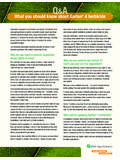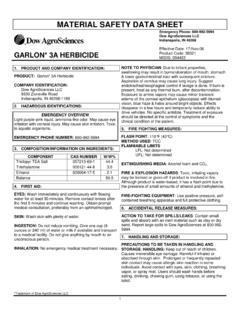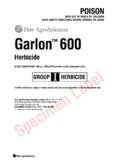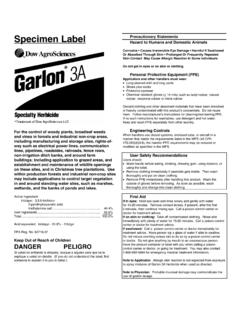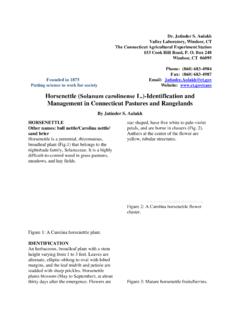Transcription of is an option for stem treatment made practical by …
1 Eradicating Eucalyptus, Acacia, and Other Invasive Trees Ken Moore -March 2008 While most of these methods may work by themselves on some tree and shrub species, weedy species almost always will not be killed unless an herbicide is applied to the entire exposed cambium layer (a narrow ring just inside the bark) within a few minutes after the cut is made. Any missed portions may result in the method not working. Herbicides commonly used are formulations containing either glyphosate or triclopyr, at 50% concentration. Stem treatments should not be done in the spring or early summer when the sap is rising in the stem. Methods are available for either cutting the tree down first, or killing it standing. Cutting the tree down.
2 You may use loppers, hand saw, or a chain saw, depending on the size of the tree. Cut the tree as close to the ground as possible, leaving a flat and level surface. Then apply herbicide to the cambium layer, around the entire circumference. Killing trees without cutting them down. There are several methods, which can be used to kill larger size shrubs or trees without cutting them down. They range from very simple hand methods to elaborate mechanical means. As trees will usually be left standing after they are killed with these techniques, the advantages and disadvantages of this must be weighed beforehand. Advantages: 1. The most cost effective and fastest way to kill very large plants, stopping the invasive process with a minimum of time and effort.
3 2. In situations where public safety is not an issue, trees left standing, as snags will provide habitat for many beneficial species. Snags will drop their limbs gradually, greatly lessening the impact when the tree finally falls. 3. There is minimal visible change on the site (compared to cutting trees down) to trigger negative viewer reaction. People are used to seeing a dead tree, but a stump is an obvious reminder for years to come. Drawbacks: 1. If trees must later be cut down and removed, the wood will harden in the first few years, making sawing difficult. 2. If many trees are killed together in a group, it may draw criticism. (Killing trees in a random pattern over time greatly reduces this visible change.) THE METHODS: Girdling, Drilling, Frilling, & Basal Bark treatments Girdling is the removal of a band of bark all the way around the tree.
4 It kills the tree by severing the cambium layer, preventing the flow of water and nutrients up and down the trunk. Several tools exist for girdling trees, including chainsaws, girdling knives, hatchets, and even torches. The fastest method is a single girdle with a chainsaw. Make sure the cut is deep enough to reach any inward folding of the bark and cambium. The herbicide is sprayed into the saw cut. If herbicides are not used, make two rings 3 or more apart completely around the tree, and remove all bark between the cuts. Drilling is an option for stem treatment made practical by the availability of higher voltage cordless drills. Drill approximately 5/16 holes at a downward angle, about 3 apart in a line around the base of the tree, and quickly fill each hole with herbicide.
5 If you are treating large numbers of trees, you will want to use at least an 18 Volt drill and have some extra batteries. If you want to charge the batteries with your vehicle through a 12 volt inverter care must be taken to avoid draining the vehicle battery. Use a flat 5/16 (Spade) drill bit to avoid clogging. Frilling involves the use of a hatchet or similar tool to slash downward through the bark and the cambium in a continuous ring around the trunk. This method is similar to girdling in that it severs the cambium layer. In thin barked species such as brooms, the bark may be then peeled down the stem to the root crown and this alone may produce mortality. When used with herbicides, the technique is sometimes referred to as Hack and Squirt It is best suited to trees at least 4 to 5 inches in diameter.
6 Use a hatchet, machete, or ax to make a series of downward cuts in the bark continuously in a ring around the entire circumference of the trunk. Immediately apply the selected herbicide into the cuts, and make sure it contacts the exposed cambium layer on the edge of the frill. Basal Bark treatment In this method, herbicide is sprayed directly on the stem of the tree or shrub. It does not require cutting through the bark. The herbicide must be absorbed through the bark, so its usefulness is limited to young trees or shrubs with thinner bark, with stem diameters of up to 6 or 8 . The herbicide is either sprayed or painted onto the bark in a band all around the stem. For this treatment , you must use an oil based herbicide such as Garlon 4A in a 50% solution of a carrier oil, such as kerosene.
7
